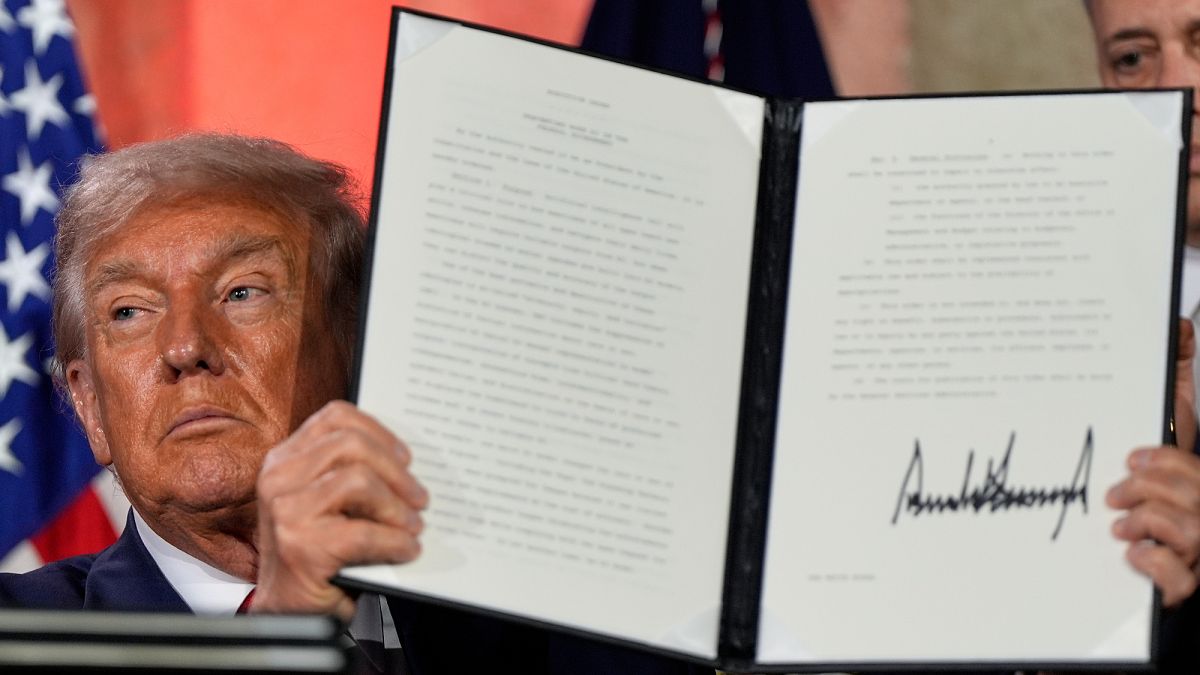US President Donald Trump has said he will keep “woke AI” models out of US government, turn the country into an “AI export powerhouse,” and weaken environmental regulation on the technology.
The announcements come as he also signed three artificial intelligence-focused executive orders on Wednesday, which are a part of the country’s so-called AI action plan.
Here is what he announced and what it means.
1. No Woke AI
One order, called “Preventing Woke AI in the Federal Government,” bans “woke AI” models and AI that isn’t “ideologically neutral” from government contracts.
It also says diversity, equity, and inclusion (DEI) is a “pervasive and destructive” ideology that can “distort the quality and accuracy of the output”. It refers to information about race, sex, transgenderism, unconscious bias, intersectionality, and systemic racism.
It aims to protect free speech and “American values,” but by removing information on topics such as DEI, climate change, and misinformation, it could wind up doing the opposite, as achieving objectivity is difficult in AI.
David Sacks, a former PayPal executive and now Trump’s top AI adviser, has been criticising “woke AI” for more than a year, fueled by Google’s February 2024 rollout of an AI image generator. When asked to show an American Founding Father, it created pictures of Black, Asian, and Native American men.
Google quickly fixed its tool, but the “Black George Washington” moment remained a parable for the problem of AI’s perceived political bias, taken up by X owner Elon Musk, venture capitalist Marc Andreessen, US Vice President JD Vance, and Republican lawmakers.
2. Global dominance, cutting regulations
The plan prioritises AI innovation and adoption, urging the removal of any barriers that could slow down adoption across industries and government. The nation’s policy, Trump said, will be to do “whatever it takes to lead the world in artificial intelligence”.
Yet it also seeks to guide the industry’s growth to address a longtime rallying point for the tech industry’s loudest Trump backers: countering the liberal bias they see in AI chatbots such as OpenAI’s ChatGPT or Google’s Gemini.
3. Streamlining AI data centre permits and less environmental regulation
Chief among the plan’s goals is to speed up permitting and loosen environmental regulation to accelerate construction on new data centres and factories. It condemns “radical climate dogma” and recommends lifting environmental restrictions, including clean air and water laws.
Trump has previously paired AI’s need for huge amounts of electricity with his own push to tap into US energy sources, including gas, coal, and nuclear.
“We will be adding at least as much electric capacity as China,” Trump said at the Wednesday event. “Every company will be given the right to build their own power plant”.
Many tech giants are already well on their way toward building new data centres in the US and around the world. OpenAI announced this week that it has switched on the first phase of a massive data centre complex in Abilene, Texas, part of an Oracle-backed project known as Stargate that Trump promoted earlier this year. Amazon, Microsoft, Meta, and xAI also have major projects underway.
The tech industry has pushed for easier permitting rules to get its computing facilities connected to power, but the AI building boom has also contributed to spiking demand for fossil fuel production, which contributes to global warming.
United Nations Secretary-General Antonio Guterres on Tuesday called on the world’s major tech firms to power data centres completely with renewables by 2030.
The plan includes a strategy to disincentivise states from aggressively regulating AI technology, calling on federal agencies not to provide funding to states with burdensome regulations.
“We need one common sense federal standard that supersedes all states, supersedes everybody,” Trump said, “so you don’t end up in litigation with 43 states at one time”.
Call for a People’s AI Action Plan
There are sharp debates on how to regulate AI, even among the influential venture capitalists who have been debating it on their favourite medium: the podcast.
While some Trump backers, particularly Andreessen, have advocated an “accelerationist” approach that aims to speed up AI advancement with minimal regulation, Sacks has described himself as taking a middle road of techno-realism.
“Technology is going to happen. Trying to stop it is like ordering the tides to stop. If we don’t do it, somebody else will,” Sacks said on the “All-In” podcast.
On Tuesday, more than 100 groups, including labour unions, parent groups, environmental justice organisations, and privacy advocates, signed a resolution opposing Trump’s embrace of industry-driven AI policy and calling for a “People’s AI Action Plan” that would “deliver first and foremost for the American people.”
Anthony Aguirre, executive director of the non-profit Future of Life Institute, told Euronews Next that Trump’s plan acknowledges the “critical risks presented by increasingly powerful AI systems,” citing bioweapons, cyberattacks, and the unpredictability of AI.
But in a statement, he said the White House should go further to protect citizens and workers.
“By continuing to rely on voluntary safety commitments from frontier AI corporations, it leaves the United States at risk of serious accidents, massive job losses, extreme concentrations of power, and the loss of human control,” Aguirre said.
“We know from experience that Big Tech promises alone are simply not enough”.

